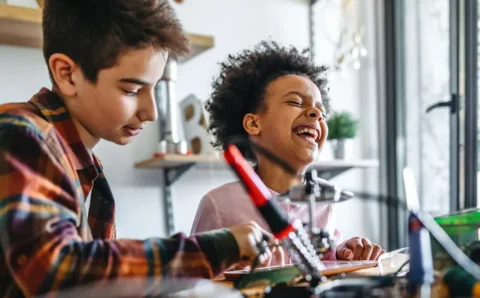Don’t just sit your students down in front of a screen and hit “Play”. They can do that at home (although see number 15!). Instead, use short clips in focused ways so every minute has a purpose. Here are practical ideas your students will actually enjoy and learn from.
1. Sound only (no picture)
Choose a short clip (around two or three minutes) where the sounds tell part of the story – footsteps, laughter, a door slamming, a phone ringing. Turn the screen away or cover it so students focus only on what they can hear. After playing, ask what they think is happening – who’s involved, where they are, and what’s going on. You can link this to a language focus such as present continuous (“A baby is crying”), past simple / past continuous, or modals of deduction (“It must be the baby”, “It might be a cat”). Then show the clip with picture and sound to compare ideas.
2. Picture only (no sound)
Show a short scene on mute – something visual with clear movement or emotion. Without sound, students notice gestures, expressions, and how people interact. Ask them to describe what’s happening using narrative tenses, or predict the dialogue and reactions. Once you’ve discussed their ideas, play it again with sound. They’ll find it much easier to make sense of what they hear, now that they’ve already explored the context visually.
3. Jigsaw viewing
Divide the class into two groups and give each half a different version of the same short video. Afterwards, they have to share what they saw or heard to piece the story together. You can set it up in a few ways:
- No picture vs no sound: Half the class watches without picture; the other half without sound. Afterwards, pairs compare notes to reconstruct what really happened.
- Back-to-back rows: Sit students back-to-back – one row can see and hear, the other can only hear. The “audio” row interviews the “video” row to fill in the gaps.
- Headphones watcher: One student listens on headphones (audio only), while the others watch on mute. The listener then describes what they heard, and the group combines both perspectives.
4. Freeze frame
Pause a video at a key moment – maybe someone’s surprised, mid-decision, or reacting to a shock. A single frozen image can spark rich discussion. Ask students to describe what they see, what might have just happened, and what could come next. Then unpause and compare with what actually happens. For vocabulary lessons, pause when there’s a lot to label on screen and build new words naturally from the scene.
5. Timeline scramble
Use a short sequence with clear events, such as a mini story or advert. Play it out of order (or jump backwards a few times) and challenge students to work out the correct sequence. Afterwards, they retell the story in order, using narrative tenses or sequencing language. You can also flip the task and have students plan what they think will happen next, using future forms (“Next, he’ll… because…”).
6. Vocabulary in context
Choose a short extract rich in useful language – dramas, interviews, and documentaries all work well. Give pairs a short list of 10–15 useful words or expressions they’ll hear in the clip, and briefly discuss meanings and possible contexts. Then play the clip once and ask them to listen for how each item is used. Afterwards, pool the results on the board to create a shared list of contextualised vocabulary.
7. Subtitles three ways
Captions can be powerful if you use them deliberately rather than leaving them on by default. Here are a few things you can try:
- L1 subtitles for confidence: Start with the sound off and L1 captions. Then play with sound on and L1 captions, and finally, with sound on and captions off. Students rely less on reading each time.
- English subtitles for reading practice: Have higher-level students read along in English, then replay with captions off and see how much they still follow.
- Auto-caption challenge: Spot funny or inaccurate auto-captions on YouTube, correct them, and re-read the lines aloud. It’s a light, useful way to focus on pronunciation and word boundaries.
8. News clips and explainers
Choose a short, visual news item or “explainer” video – YouTube Shorts and Instagram Reels work well. They’re ideal for gist tasks and retelling. Play the clip once with no sound and ask groups to discuss what they think it’s about. Then give them a few key vocabulary items from the clip and play it again, this time with sound. Finally, they compare their version of the story with the original.
9. Short-form predictions (TikTok / Reels / Shorts)
Use ultra-short clips (5–20 seconds) that build up to a single moment – a reveal, a trick, or a reaction. Pause just before the “beat” and have students predict what’s about to happen. Watch a few more seconds, pause again, and keep predicting until the end. Afterwards, discuss whose ideas were closest. Focus on language for speculating if you like (“I think…”, “Maybe…”, “It could be…”).
10. Caption it
Mute a clip and challenge students to write captions – subtitles, thought bubbles, or a one-line social post. It’s simple, creative, and great for writing accuracy. Pairs can draft one-liners or a few subtitle lines, then replay the clip with sound to compare. You can finish with a quick vote for the funniest, clearest, or most natural caption.
11. Reaction takes
After watching a clip, have students record a short “reaction” – 15 to 30 seconds of audio or video where they give their opinion or advice to one of the characters. It’s a low-pressure, personalised way to get speaking practice. Focus on language for giving opinions, agreeing or disagreeing, and making suggestions (“You should…”, “I’d…”, “You could…”).
12. DIY micro-videos
Students create their own 10–20 second silent “mini-scenes” on their phones – no faces needed if privacy is a concern. Keep it light and playful. For example, a group could film a silent “shop” scene for classmates to script later, or record themselves walking somewhere for others to give directions.
13. “Voices in my head”
Choose a short scene with expressive dialogue between two or more characters. Play the clip and check comprehension first. Then divide the class into groups – one per character. Each group’s task is to imagine what their character is really thinking during the scene. You might replay the video several times so students can pick up on tone and body language. Finally, play it again, pausing after each character speaks, and have the groups add what they think that person’s inner voice might say. It’s a creative way to explore subtext, tone, and emotion.
14. Cultural snapshots
Find a short clip that shows an everyday cultural moment – greetings, queues, small talk, even eating habits. Students don’t need to understand every word to engage. After watching, groups discuss what seems familiar or different from their own culture, then do a short role-play using the same social situation. It’s a natural way to explore culture through language rather than just talking about it abstractly.
15. Popcorn and personal picks
Sometimes the best way to use video is simply to enjoy it together. At the end of a course, set aside a short “popcorn” session – a chance for everyone to relax, watch something uplifting, and remember that English is also for pleasure, humour, and connection. Choose a short film, advert, or animation, and just watch it as a class – no worksheets, no tasks. Afterwards, have a light chat about what people liked, what made them laugh, or what message they took from it. It’s a simple way to connect and celebrate how far they’ve come.
Or turn it around and let your students bring the videos. Ask each student or pair to choose a short clip they enjoy – a funny advert, a song video, a sports highlight, or a short film – and introduce it to the class. Set some guidelines (keep it under a minute, suitable for all, and in English or with subtitles). The aim isn’t to teach or correct, but to share something personal in English and explain why they like it. You’ll often get lively discussions, laughter, and a genuine sense of pride as students use English to talk about something that really matters to them.
Practical notes
- Keep clips short: 30–90 seconds is usually enough for focused tasks, especially when using TikTok, Reels, or Shorts.
- Safety and privacy: If students make clips, avoid faces unless everyone’s happy and you have permission. Keep sharing within the class.
- Copyright: Use short extracts, link rather than copy where possible, and use official channels.
- Accessibility: Provide captions or transcripts where appropriate; balance sound-only and picture-only tasks so all learners can take part.
Final thoughts
Video can be so much more than passive watching – it can bring language, culture, and real emotion into the classroom. Keep it short, stay purposeful, and your students will quickly see that watching in English can also mean thinking, reacting, and creating in English.
How do you use video in your classes? Share your ideas in the comments below.









3 comments
Olga
I finally found someone who thinks that movies are a great source for students. I used movies a lot, but my colleagues, even the directors, criticized me for it. I brought them this article. Thank you.
Ranee
It’s a good idea, thanks for sharing. What I have done is to choose a suitable movie which is relevant to the topic we are discussing… students watch the movie, and after I give them a lot of questions dealing with the characters seen in the movie which can be for oral, writing, expression purposes…
Jonny
Great ideas. My classroom has a lot of technology and I’m always looking for ways to utilize it better. Thanks!